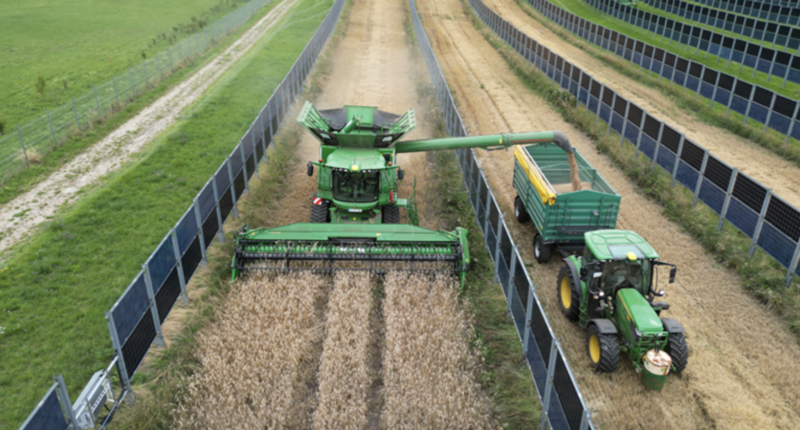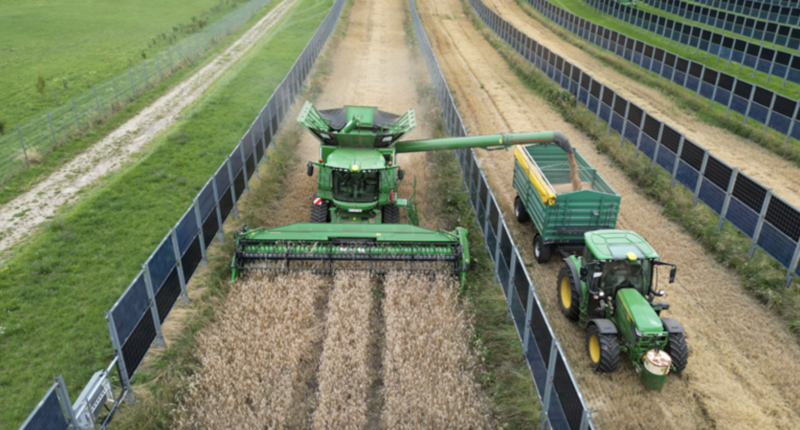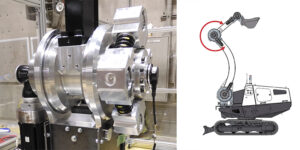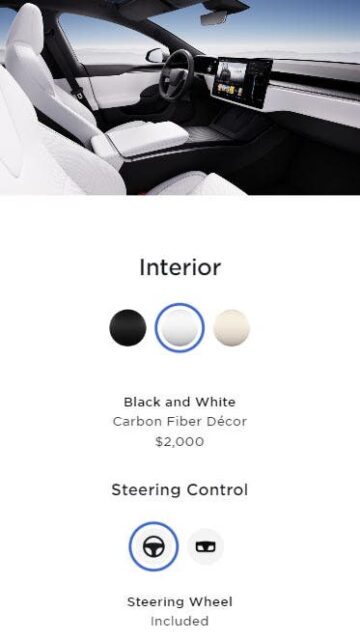
Sign up for daily news updates from CleanTechnica on email. Or follow us on Google News!
The rarefied world of saffron cultivation is about to encounter a solar makeover. About 90% of the global saffron supply comes from Iran, but the allure of raising a spice crop that retails for $5,000 a pound could widen the territory. That includes the unlikely state of Vermont, where a new agrivoltaic experiment is under way. If all goes according to plan, it could pave the way for for a saffron boom in the US and help save small farms, to boot.
The Agrivoltaic Advantage
Conventional solar arrays are designed with little attention to ground cover. An agrivoltaic array is different. The solar panels are arranged to enable various kinds of farming to take place. Raising the panels higher off the ground is one typical strategy, for example.
The field of agrivoltaics is a new discipline. It emerged just a few years ago, with a focus on cultivating native habitats and grazing lands. It has already exploded in all sorts of different directions, with new strategies for growing food crops, new robotic systems, and new designs for arranging crop-friendly solar panels (see lots more coverage here).
The mutual benefits of agrivoltaic arrays have also surfaced rapidly. A properly designed array can improve yields by shielding crops from excessive sun. and improve soil by retaining moisture and preventing erosion. Meanwhile, the cooling microclimate of vegetation helps to improve solar conversion efficiency.
In terms of overall sustainability, the combination of solar panels and farming can help encourage more farmers to continue working the land, rather than turning it over for the construction of housing, corporate parks, fulfillment centers and other forms of permanent development.
The Bifacial Solar Panel Difference
The challenge for agrivoltaic developers is to balance the output of the solar array with the efficient operation of the host farm. That can limit the number of solar panels in a given area, or it can limit the use of large-scale tractors, mowers, and other equipment typical of modern farming operations.
Those limitations have been eased by new bifacial solar technology. Bifacial solar panels capture solar energy from their rear side as well as the front, enabling them to function efficiently in a space-saving vertical position. In contrast, conventional solar panels take up more space because they are aligned at an angle.
Due to their vertical position, bifacial solar panels can double as fencing. They can also collect more solar energy than conventional, tilted arrays during early morning and late afternoon hours. Solar producers can generally get a higher rate for their electricity during these off-peak solar production hours.
The Vermont Agrivoltaic Project
Since bifacial solar panels can be spaced farther apart than conventional solar panels, they provide more room for farming machinery to operate in between. That’s not necessarily a benefit for saffron cultivation, which depends largely on manual labor. However, there could be other benefits to having more space between the solar panels, and that seems to be the motivation behind the new agrivoltaic pilot project taking shape in Vermont, as a partnership between the US solar installer iSun and the German bifacial solar firm Next2Sun.
The new bifacial solar panels will be installed on a plot of land measuring 3.7 acres. There will be 69 units spaced 30 feet apart. Each unit is composed of two bifacial solar modules.
The plan is to grow beets, carrots, and other vegetables along with saffron.
So…Why Saffron?
The choice of Vermont for this particular project is no accident. Researchers at the University of Vermont have been pitching saffron cultivation as a way to help specialty crop farmers stay in business and preserve cultivated land for future generations.
Saffron comes from the stigmas of the blooming crocus. In addition to medicinal benefits and other non-culinary uses, saffron really is the most expensive spice in the world at $5,000 per pound. In comparison, vanilla clocks in a distant second at $600 per pound.
About 170,000 blooms are needed to make one pound of saffron, and the flowers only bloom during a six-week period, which explains the commonly cited figure of $5,000 per pound.
The school has been researching saffron since 2015, calling it a “golden opportunity for diversified growers in New England.”
The agrivoltaic program was inspired by the success of a previous saffron cultivation conducted by the school. Rather than building whole hothouses to grow specialty crops during harsh climates and seasons, high tunnel cultivation deploys long rows of hoop-style plastic covers.
“These structures allow growers to extend the growing season, providing conditions in which to grow crops that otherwise would not survive,” UV explains.
The problem is that the competition is hot for conventional high tunnel crops like tomatoes and greens. UV researchers went looking for a more specialized specialty crop and they found saffron.
The high tunnel project indicated that Vermont farmers could generate $100,000 per acre from saffron at $4.03 per square foot, compared $3.51 for tomatoes and $1.81 for winter greens.
Saffron Meets Agrivoltaics
The foundation for the new agrivoltaic project was laid by saffron expert Arash Ghalehgolabbehbahani of the University of Vermont’s North American Center for Saffron Research and Development, along with researchers Bruce L. Parker and Margaret Skinner.
In a reported published in February of 2022, they noted that 90% of US farms are ranked as “‘small’ family operations.”
“Production of specialty crops boosts economic returns for small farms, and increased profitability is critical to keep these farms operating,” they wrote.
They also noted that the US has been losing about 40 acres of farmland every 60 minutes in recent years, “mostly to urban sprawl and non-agricultural development.”
Though some rural solar opponents seem more interested in spreading climate misinformation than saving farmland, the UV researchers asserted that “novel high-value crops grown within solar arrays could enhance agricultural revenues and contribute to keeping farming a viable enterprise.”
With that in mind, back in 2018 the school embarked on an agrivoltaic research project with iSun (formerly Peck Solar), using conventional tilted solar panels.
The project involved collecting data on saffron cultivation within the solar array from 2019 to 2021. The three-year period accounted for the complex, multi-cycle growth pattern of the crocuses.
Testing The Bifacial Advantage
The project involved the installation of conventional, tilted solar panels, enabling the researchers to plant crocuses directly under the solar panels as well as in between.
The researchers noted that conditions under the panels were “less than ideal” for growing saffron, but the row-planted crops fared well enough to declare a win for agrivoltaics.
“Overall, this study showed that saffron is a viable crop for cultivation in association with fixed tilted solar arrays, and indeed it is a win/win opportunity that makes good use of land within an array, while also generating renewable power to reduce the negative environmental effects of traditional petroleum-based energy sources,” they concluded.
The new partnership with iSun and Next2Sun appears aimed at taking full advantage of in-row plantings, with the installation of vertical, bifacial solar panels. We might have to wait another three years for the results. In the meantime, CleanTechnica is reaching out to UV to find out how the first saffron agrivoltaic project compares with high tunnel planting, so stay tuned for more on that.
Follow me @tinamcasey on Bluesky, Threads, Post, and LinkedIn.
Photo: Agrivoltaic array combining bifacial solar panels with farming (courtesy of Next2Sun).
Have a tip for CleanTechnica? Want to advertise? Want to suggest a guest for our CleanTech Talk podcast? Contact us here.
Our Latest EVObsession Video
[embedded content]
I don’t like paywalls. You don’t like paywalls. Who likes paywalls? Here at CleanTechnica, we implemented a limited paywall for a while, but it always felt wrong — and it was always tough to decide what we should put behind there. In theory, your most exclusive and best content goes behind a paywall. But then fewer people read it!! So, we’ve decided to completely nix paywalls here at CleanTechnica. But…
Thank you!
Advertisement
CleanTechnica uses affiliate links. See our policy here.
- SEO Powered Content & PR Distribution. Get Amplified Today.
- PlatoData.Network Vertical Generative Ai. Empower Yourself. Access Here.
- PlatoAiStream. Web3 Intelligence. Knowledge Amplified. Access Here.
- PlatoESG. Carbon, CleanTech, Energy, Environment, Solar, Waste Management. Access Here.
- PlatoHealth. Biotech and Clinical Trials Intelligence. Access Here.
- Source: https://cleantechnica.com/2024/01/02/solar-panels-agrivoltaic-saffron-usa-vermont/
- :has
- :is
- :not
- :where
- $3
- $UP
- 000
- 15%
- 2015
- 2018
- 2019
- 2021
- 2022
- 30
- 36
- 40
- 51
- 60
- 7
- a
- About
- accident
- According
- accounted
- acre
- acres
- addition
- ADvantage
- Advertise
- Affiliate
- ago
- Agricultural
- aimed
- aligned
- All
- allow
- allure
- along
- already
- also
- always
- American
- an
- and
- Another
- apart
- appears
- ARE
- AREA
- arranged
- Array
- AS
- Association
- At
- attention
- back
- Balance
- BE
- because
- been
- behind
- benefit
- benefits
- BEST
- between
- Bit
- Bloom
- bluesky
- boom
- boosts
- Bruce
- Building
- business
- but
- by
- calling
- CAN
- capture
- Center
- Centers
- challenge
- chip
- choice
- cited
- cleantech
- Cleantech Talk
- Climate
- Clocks
- collect
- Collecting
- combination
- combining
- comes
- commonly
- Companies
- compared
- comparison
- competition
- completely
- complex
- composed
- concluded
- conditions
- conducted
- construction
- content
- continue
- contrast
- contribute
- conventional
- Conversion
- Corporate
- could
- cover
- coverage
- covers
- critical
- crop
- crops
- cultivation
- data
- decide
- decided
- depends
- deploys
- designed
- designs
- developers
- Development
- different
- directions
- directly
- discipline
- Distant
- diversified
- don
- double
- during
- each
- Early
- Economic
- effects
- efficiency
- efficient
- efficiently
- electricity
- embarked
- embedded
- emerged
- enable
- enabling
- encounter
- encourage
- energy
- England
- enhance
- enough
- Enterprise
- environmental
- equipment
- Every
- example
- excessive
- Exclusive
- expensive
- experiment
- expert
- Explains
- extend
- family
- farm
- farmers
- farming
- farmland
- Farms
- February
- Feet
- felt
- fencing
- few
- fewer
- field
- Figure
- Find
- Firm
- First
- fixed
- Focus
- Foot
- For
- formerly
- forms
- found
- Foundation
- from
- front
- fulfillment
- full
- function
- future
- generally
- generate
- generating
- generations
- German
- get
- given
- Global
- Goes
- good
- greens
- Ground
- Grow
- growers
- Growing
- grown
- Growth
- Guest
- Have
- having
- help
- helps
- here
- High
- higher
- host
- HOT
- HOURS
- housing
- How
- However
- HTTPS
- if
- implemented
- improve
- in
- includes
- increased
- indicated
- inspired
- installation
- interested
- involved
- Iran
- IT
- jpg
- just
- Keep
- keeping
- labor
- Land
- large-scale
- largely
- Late
- latest
- like
- likes
- LIMIT
- limitations
- Limited
- links
- little
- Long
- looking
- losing
- lots
- machinery
- make
- MAKES
- manual
- me
- meantime
- Meanwhile
- measuring
- Media
- medicinal
- Meet
- Meets
- might
- mind
- minutes
- Modern
- Modules
- more
- morning
- most
- Motivation
- mutual
- necessarily
- Need
- needed
- negative
- New
- news
- no
- North
- noted
- number
- of
- off
- on
- ONE
- only
- operate
- operating
- operation
- Operations
- Opportunity
- or
- Other
- otherwise
- our
- out
- output
- over
- overall
- panel
- panels
- parks
- particular
- Partnership
- Pattern
- pave
- People
- per
- period
- permanent
- pilot
- pilot project
- pitching
- Place
- plan
- plant
- Planting
- plastic
- plato
- Plato Data Intelligence
- PlatoData
- player
- podcast
- policy
- position
- Post
- pound
- power
- preventing
- previous
- Problem
- Producers
- Production
- profitability
- Program
- project
- properly
- provide
- providing
- publish
- published
- put
- raising
- ranked
- rapidly
- Rate
- rather
- reaching
- Read
- Reader
- really
- recent
- reduce
- Renewable
- Reported
- research
- research and development
- researchers
- Results
- retaining
- returns
- revenues
- Room
- Save
- saving
- School
- Season
- seasons
- Second
- see
- seem
- seems
- Shape
- should
- showed
- side
- since
- small
- So
- soil
- solar
- solar energy
- solar panel
- solar panels
- some
- Sources
- Space
- specialized
- Specialty
- spice
- square
- State
- stay
- Stories
- strategies
- Strategy
- structures
- Study
- success
- suggest
- Sun
- supply
- support
- survive
- Sustainability
- T
- Take
- taking
- Talk
- team
- terms
- territory
- than
- that
- The
- the world
- their
- Them
- then
- theory
- There.
- These
- they
- this
- three
- tip
- to
- tough
- traditional
- tunnel
- Turning
- two
- typical
- under
- unit
- units
- university
- unlikely
- Updates
- urban
- us
- use
- uses
- using
- various
- Ve
- Vegetables
- Vermont
- vertical
- viable
- Video
- wait
- want
- was
- Way..
- we
- WELL
- went
- were
- What
- which
- while
- WHO
- whole
- will
- win
- Winter
- with
- within
- working
- world
- would
- write
- Wrong
- wrote
- years
- yields
- you
- Your
- youtube
- zephyrnet









